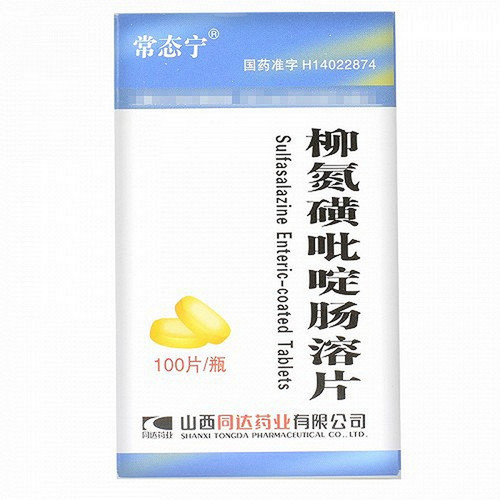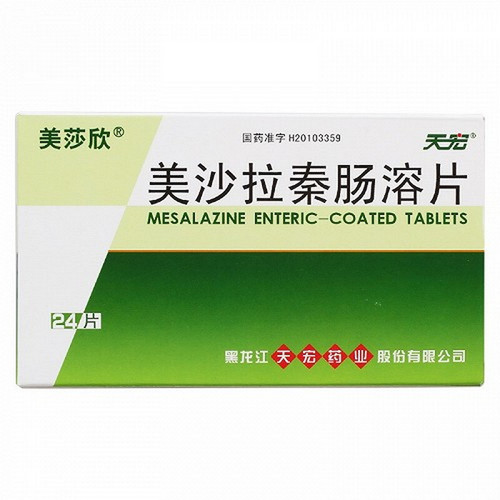Product Overview
[Drug Name]
Trade Name: Xinyi
English Name: Sulfasalazine Enteric-coated Tablets
Chinese Pinyin: Liudanhuangbiding Pian
[Ingredients]
The main ingredient of this product is sulfasalazine.
[Properties]
This product is an enteric-coated tablet that appears brown after removing the coating.
[Indications]
Primarily used for inflammatory bowel disease, namely Crohn's disease and ulcerative colitis.
[Dosage and Administration]
Oral. The usual adult dosage is: The initial dose is 2-3 g per day, divided into 3-4 oral doses. If no significant discomfort is noted, the dose can be gradually increased to 4-6 g per day. After bowel symptoms resolve, the dose can be gradually reduced to a maintenance dose of 1.5-2 g per day. For children, the initial dose is 40-60 mg/kg per day, divided into 3-6 oral doses. After the condition resolves, the maintenance dose is 30 mg/kg per day, divided into 3-4 oral doses.
[Adverse Reactions]
The serum concentration of sulfapyridine and its metabolites (20-40 μg/ml) is associated with toxicity. Concentrations exceeding 50 μg/ml are toxic, so the dose should be reduced to avoid toxic reactions. 1. Allergic reactions are common and may manifest as drug rashes. In severe cases, exudative erythema multiforme, exfoliative dermatitis, and epidermolysis bullosa may occur. Serum sickness-like reactions may also occur, including photosensitivity, drug fever, joint and muscle pain, and fever. 2. Neutropenia or neutropenia, thrombocytopenia, and aplastic anemia. Patients may experience sore throat, fever, pallor, and a bleeding tendency. 3. Hemolytic anemia and hemoglobinuria. These reactions are more common in patients with glucose-6-phosphate dehydrogenase deficiency and are more common in newborns and children than in adults.
[Contraindications]
This product is contraindicated in patients allergic to sulfonamides, pregnant women, breastfeeding women, and children under 2 years of age.
[Precautions]
1. Use with caution in patients with glucose-6-phosphate dehydrogenase deficiency, liver or renal impairment, porphyria, thrombocytopenia, granulocytopenia, porphyria, or intestinal or urinary tract obstruction. 2. Drink plenty of fluids and maintain a high urine flow during sulfonamide use to prevent crystallization of the urine. If necessary, administer urine alkalinizing medications. For long-term or high-dose treatment, this product should be taken with sodium bicarbonate and plenty of fluids to prevent these adverse reactions. During treatment, perform a urinalysis at least 2-3 times weekly. If crystallization or hematuria is detected, administer sodium bicarbonate and plenty of water until the crystallization or hematuria disappears. This product should be used with caution or avoided in patients with dehydration, shock, or the elderly, as it can cause renal damage. 3 Patients who are allergic to furosemide, sulfones, thiazide diuretics, sulfonylureas, carbonic anhydrase inhibitors and other sulfonamides may also be allergic to this product. 4 During treatment, the following examinations should be taken: (1) Complete blood test, which is especially important for patients receiving a longer course of treatment. (2) Proctoscopy and sigmoidoscopy to observe the effect of the medication and adjust the dose. (3) Regular urine tests during treatment (urinalysis every 2 to 3 days) to detect crystalluria that may occur during long-term or high-dose treatment. (4) Liver and kidney function tests. 5 In case of gastrointestinal irritation symptoms, in addition to emphasizing taking the medicine after meals, it can also be divided into small doses and taken multiple times, even once every hour, to relieve the symptoms. 6 Adjust the dose at any time according to the patient's response and drug tolerance. Some patients can adopt intermittent treatment (two weeks of medication, one week of rest). 7 If diarrhea symptoms do not improve, the dose can be increased. 8 The interval between nocturnal drug withdrawal should not exceed 8 hours. 9 Patients with impaired renal function should reduce the dose.
[Use in Special Populations]
Precautions for Children:
Because sulfonamides can compete with bilirubin for binding sites on plasma proteins, and because the acetyltransferase system in newborns is not fully developed, free sulfonamide blood concentrations increase, increasing the risk of kernicterus. Therefore, these drugs should not be used in newborns and children under two years of age.
Precautions for Pregnancy and Breastfeeding:
1. Sulfonamides can cross the blood-pelvic barrier and reach the fetus. Animal studies have shown teratogenic effects. Insufficient data are available from human studies, so their use should be avoided in pregnant women. 2. Sulfonamides are excreted in breast milk, with concentrations reaching approximately 50%-100% of maternal blood concentrations. These drugs may affect infants. Sulfonamide use in newborns with glucose-6-phosphate dehydrogenase deficiency may cause hemolytic anemia. Therefore, their use should be avoided in breastfeeding women.
Precautions for the Elderly:
Senior patients are more likely to experience serious adverse reactions from sulfonamides. Severe rash, bone marrow suppression, and thrombocytopenia are common serious adverse reactions in the elderly. Therefore, it should be avoided in elderly patients. When indicated, the decision should be made after weighing the pros and cons.
[Drug Interactions]
1. Concomitant use with urinary alkalinizing agents may increase the solubility of sulfonamides in alkaline urine, leading to increased excretion. 2. Para-aminobenzoic acid can displace sulfonamides for bacterial uptake, antagonizing the antibacterial effects of sulfonamides. Therefore, the two drugs should not be used together. 3. When the following drugs are used together with sulfonamides, the latter can displace the protein binding sites of these drugs or inhibit their metabolism, resulting in prolonged drug action or toxicity. Therefore, the dosage of these drugs should be adjusted when used together with sulfonamides or after sulfonamides. These drugs include oral anticoagulants, oral hypoglycemic agents, methotrexate, phenytoin sodium, and thiopental sodium. 4. Concomitant use of myelosuppressive drugs with sulfonamides may enhance the adverse effects of these drugs on the hematopoietic system. If combined use of these two drugs is indicated, close observation for possible toxic reactions should be conducted. 5. Long-term combined use of contraceptives (estrogens) and sulfonamides can reduce contraceptive effectiveness and increase the risk of extramenstrual bleeding. 6. Combining thrombolytics with sulfonamides may increase their potential toxic effects. 7. Combining hepatotoxic drugs with sulfonamides may increase the incidence of hepatotoxicity. Liver function should be monitored in such patients, especially those taking the drugs for a long time and those with a history of liver disease. 8. Combining photosensitizing drugs with sulfonamides may result in additive photosensitivity. 9. Patients receiving sulfonamide therapy have an increased requirement for vitamin K. 10. Hexamethylenetetramine decomposes in acidic urine to produce formaldehyde, which can form an insoluble precipitate with sulfonamides. This increases the risk of crystalluria, so the two drugs should not be used together. 11. Sulfonamides can replace the plasma protein binding sites of phenylbutazone, enhancing the effects of phenylbutazone when used together. 12. When sulfinpyrazone is used concomitantly with sulfonamides, it can reduce renal tubular secretion of the latter, leading to elevated and prolonged blood concentrations and potentially toxic effects. Therefore, the sulfonamide dosage may need to be adjusted during or after sulfinpyrazone treatment. When sulfinpyrazone treatment is prolonged, monitoring the sulfonamide blood concentration is advisable to facilitate dosage adjustment and ensure safe use. 13. When used concomitantly with digitalis or folic acid, the latter's absorption is reduced, leading to lower blood concentrations. Therefore, the effects and efficacy of digitalis must be monitored at all times. 14. Concomitant use with probenecid can reduce renal tubular sulfonamide excretion, leading to elevated blood concentrations, prolonged effects, and increased risk of toxicity. 15. When used concomitantly with neomycin, neomycin inhibits intestinal flora, affecting the drug's intestinal breakdown and reducing its effectiveness.
[Pharmacological Action]
This product is a sulfonamide antibiotic. It is poorly absorbed orally. The absorbed portion is broken down into 5-aminosalicylic acid and sulfapyridine by intestinal microorganisms. 5-aminosalicylic acid binds to the intestinal connective tissue and remains there for a long time, exerting antibacterial, anti-inflammatory, and immunosuppressive effects. For example, it reduces the growth of Escherichia coli and Clostridium difficile bacteria while inhibiting the synthesis of prostaglandins and other inflammatory mediators, such as leukotrienes. Therefore, it is currently believed that the primary component of this product's efficacy in treating inflammatory bowel disease is 5-aminosalicylic acid. The sulfapyridine produced by its decomposition exhibits a weak antibacterial effect against intestinal flora.
[Storage]
Store in a dark, airtight container.
[Specification]
0.25g
[Packaging Size]
0.25g x 100s
[Expiry Date]
24 months
[Approval Number]
National Medicine Standard H31020840
[Manufacturer]
Company Name: Shanghai Fuda Pharmaceutical Co., Ltd.







